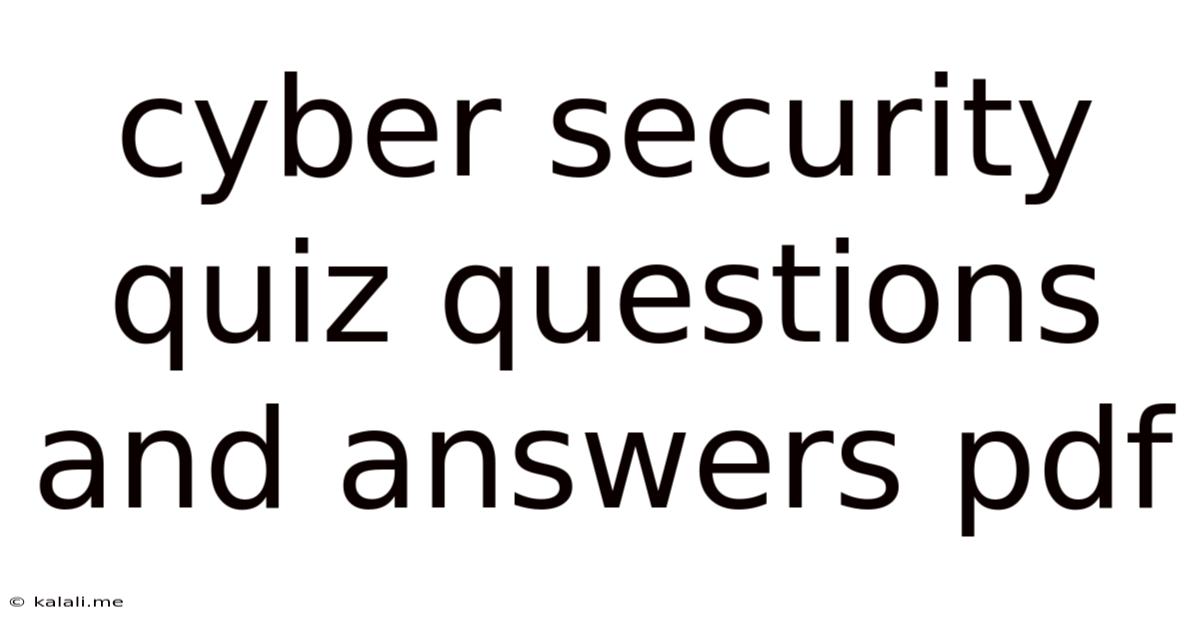Cyber Security Quiz Questions And Answers Pdf
Kalali
Jun 11, 2025 · 3 min read

Table of Contents
Ace Your Cybersecurity Knowledge: Quiz Questions & Answers
Are you looking to test your cybersecurity knowledge or brush up on essential concepts? This comprehensive guide provides a series of quiz questions and answers covering key aspects of cybersecurity. Whether you're a student, professional, or simply interested in improving your digital safety, this resource will help you assess your understanding and identify areas for improvement. Downloading a PDF might seem convenient, but this interactive format allows for better engagement and a deeper understanding of the subject matter.
Why Cybersecurity Matters: In today's digital world, cybersecurity is paramount. Protecting personal information, sensitive data, and online infrastructure from cyber threats is crucial for individuals and organizations alike. This quiz will cover various crucial topics including network security, data protection, social engineering, malware, and best practices for online safety.
Section 1: Network Security
-
What is a firewall?
- A. A physical barrier protecting computer equipment.
- B. A software or hardware system that controls the flow of network traffic.
- C. A type of antivirus software.
- D. A type of encryption algorithm.
Answer: B A firewall filters incoming and outgoing network traffic based on predefined rules.
-
What does VPN stand for?
- A. Virtual Private Network
- B. Very Private Network
- C. Virtual Public Network
- D. Very Public Network
Answer: A A VPN creates a secure, encrypted connection over a public network.
-
Which protocol is commonly used for secure web communication?
- A. FTP
- B. HTTP
- C. HTTPS
- D. SMTP
Answer: C HTTPS uses SSL/TLS encryption to protect data transmitted between a web browser and a server.
Section 2: Data Protection & Privacy
-
What is phishing?
- A. A type of malware
- B. A deceptive attempt to obtain sensitive information such as usernames, passwords, and credit card details.
- C. A type of network attack
- D. A type of denial-of-service attack
Answer: B Phishing often involves fraudulent emails or websites.
-
What is data encryption?
- A. The process of converting readable data into an unreadable format.
- B. The process of converting unreadable data into a readable format.
- C. The process of deleting data.
- D. The process of backing up data.
Answer: A Encryption protects sensitive data by making it inaccessible without the correct decryption key.
-
What is two-factor authentication (2FA)?
- A. Using two different passwords for different accounts.
- B. Using a password and a second verification method, such as a code from a mobile app or email.
- C. Using biometric authentication only.
- D. Using a password manager.
Answer: B 2FA adds an extra layer of security to online accounts.
Section 3: Malware & Threats
-
What is malware?
- A. Malicious software designed to damage or disable computer systems.
- B. A type of network hardware.
- C. A type of operating system.
- D. A type of programming language.
Answer: A Malware encompasses viruses, worms, Trojans, ransomware, and spyware.
-
What is ransomware?
- A. Malware that encrypts a victim's files and demands a ransom for their release.
- B. Malware that steals personal information.
- C. Malware that slows down a computer.
- D. Malware that displays unwanted ads.
Answer: A Ransomware is a particularly dangerous type of malware.
-
What is a virus?
- A. A self-replicating program that spreads from one computer to another.
- B. A type of network attack.
- C. A type of hardware failure.
- D. A type of software update.
Answer: A Viruses often require user interaction to spread, for example, opening an infected email attachment.
Section 4: Best Practices
-
What is a strong password?
- A. A password that is easy to remember.
- B. A password that is at least 8 characters long, includes uppercase and lowercase letters, numbers, and symbols, and is unique to each account.
- C. A password that is written down and kept in a safe place.
- D. A password that is the same for all accounts.
Answer: B Using strong, unique passwords for each account is crucial for online security.
This quiz provides a foundational understanding of key cybersecurity concepts. Remember, staying informed and practicing good online habits are crucial for protecting yourself and your data in the ever-evolving digital landscape. Continuous learning and awareness are key to effective cybersecurity.
Latest Posts
Latest Posts
-
What Is Half Of 1 4 Teaspoon
Jul 02, 2025
-
How Many Cups In A Pound Of Hamburger Meat
Jul 02, 2025
-
Imagery Or Figurative Language From Romeo And Juliet
Jul 02, 2025
-
What Is A Quarter Of A Million
Jul 02, 2025
-
Which Of The Following Is True Concerning A Dao
Jul 02, 2025
Related Post
Thank you for visiting our website which covers about Cyber Security Quiz Questions And Answers Pdf . We hope the information provided has been useful to you. Feel free to contact us if you have any questions or need further assistance. See you next time and don't miss to bookmark.